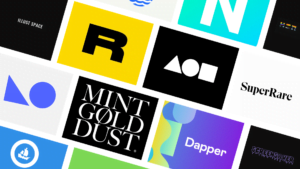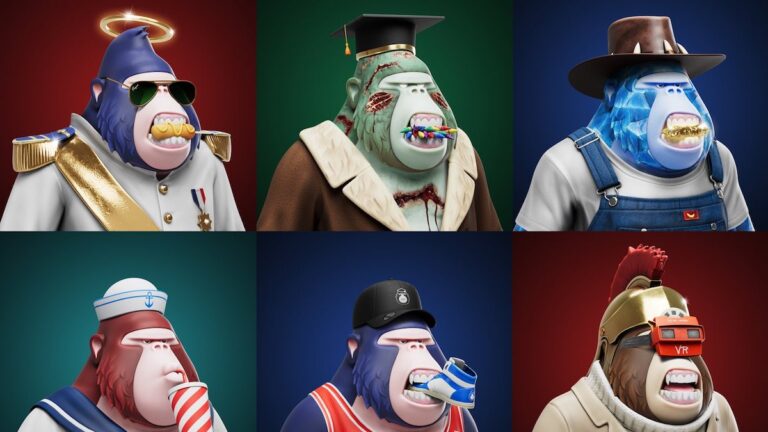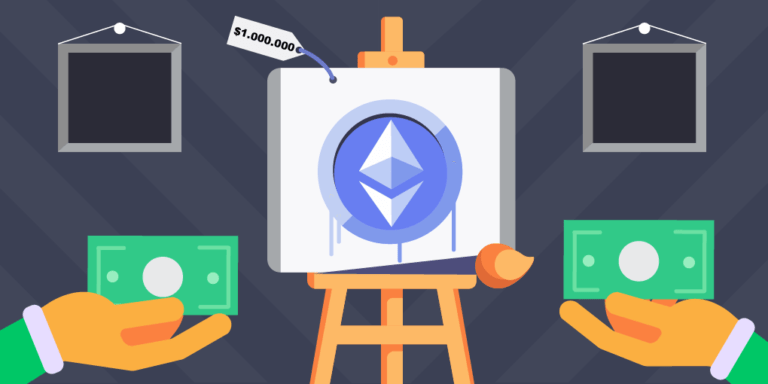Art collectors are willing to pay a lot of money for rare pieces of digital art, but frauds and fakes can easily emerge in this domain. The NFT marketplaces seek to solve the problem of counterfeits and also facilitate safe trade.
The NFT marketplace is a digital platform where artists upload a piece of their art, turn it into a non-fungible token and then trade it. Once the NFT is generated, it can be bought, sold or stored as a long-term investment on the NFT marketplaces.
There are many NFT marketplaces that have emerged in 2021. Most of them provide tremendous possibilities for both artists and collectors. Artists can choose to auction their artwork or to sell it at a predetermined price. Buyers can then trade the NFTs on any of these platforms.
We created a list of the Top 5 NFT marketplaces that allow you to create, purchase and trade NFTs at reasonable prices.
1.OpenSea
Built on the Ethereum blockchain, OpenSea is the largest and most popular marketplace specializing in the sale and purchase of NFTs. On this platform you will find a wide range of ERC-721 and ERC-1155 tokens that you can trade. OpenSea provides a wide range of NFTs, including digital art, trading cards, sports, music, games, domain names and crypto collections.
OpenSea debuted in November 2017 and by 2021, the marketplace has significantly grown. Now it has the highest trading volume (196.67 million dollars worth) on a daily basis, providing over 10 million digital assets from more than 300 projects.
You can create your own tokens on the Ethereum blockchain using OpenSea’s item minting tool. If you are a developer or a digital artist, you can make your own NFT collection. On the OpenSea platform you have the opportunity to create your own ERC721 and ERC1155 tokens that you can sell using your Ethereum wallet.
Advantages of using the OpenSea marketplace:
- Current leader on the NFT marketplaces
- Offers valuable digital collections
- Low transaction costs
- Supports ERC-721 and ERC-1155 tokens
- Customizable artist royalties
- 2.5% fee on each transaction
2. SuperRare
The SuperRare NFT marketplace was launched in 2017. On this platform, digital artists create a piece of art and turn it into a NFT based on the Ethereum blockchain. In 2020, SuperRare collaborated with DADA.art for an event at the Tate Modern Museum in London. It was the first time that art pieces were created in a world-class museum and immediately made available to collectors around the world.
The SuperRare platform allows the original creator of the NFT to collect a fee from the resale prices. Basically, every time an NFT is resold, the creator earns a commission. For the first sale of a new piece of art, the original creator receives 85% of the commission, while the gallery receives 15%. For any subsequent sale, the creators receive a 3% commission. To date, more than 5,000 works of art have been created, with fees of more than 500,000 dollars collected by digital artists.
SuperRare has managed to earn its place in the Top 5 NFT marketplaces through a smart marketing strategy. Creators John Crain, Charles Crain and Johnathan Perkins popularized it based on the concept of “social collecting”. The users of the platform can see who are the top collectors and artists, how many pieces they bought or created and the ETH value of the pieces. They can also view the art object itself, along with a description and history of the owners.
Advantages of using the SuperRare marketplace:
- Supports ERC-721 tokens
- Exclusivity
- 3% commission for any subsequent sale
Disadvantages of using the SuperRare marketplace:
- 15% fee on each transaction
- 10% artist royalty
- Invite only
3. Rarible
Rarible is a decentralized application (dapp) based on the Ethereum blockchain and also one of the best NFT marketplaces. It allows users to use a feature to create their own NFTs, which means tokenizing their collections.
A notable feature of the Rarible platform is the configuration of its governance. Through its native utility token (RARI), users can participate in the protocol governance decisions through a voting mechanism. The Rarible implementation of a decentralized autonomous organization (DAO) is a very important advantage for users. Such a feature does not exist in most NFT markets.
RARI is the utility symbol of Rarible. Users can earn these tokens from various activities on the platform, such as buying or selling works of art or collections known as „Marketplace liquidity mining”. The RARI token gives owners the right to decide on system updates for Rarible and to determine what content is marketed on the platform.
Rarible was founded in early 2020 by Alex Salnikov and Alexei Falin. Their vision is to create a successful blockchain application with a focus on helping artists and collection owners.
Advantages of using the Rarible marketplace:
- RARI token rewards creators and collectors
- Enables users to influence decisions of the platform
- Decentralized DAO
- Supports ERC-721 and ERC-1155 tokens
- Customizable artist royalties
- 2.5% fee on each transaction
4. Foundation
The Foundation NFT marketplace was created in 2020 and it calls itself the “new creative economy”. It mostly focuses on digital art. After the resale of an NFT, the artist receives 10% of the sales value.
Art collectors can place bids on the artworks available on Foundation. After they meet the artist’s “reserve price”, a 24-hour auction begins. Content creators can view the list of current bids made by investors in Ethereum cryptocurrency.
In August 2021, the Foundation marketplace had a trading volume of 76.19 million dollars. With thousands of users, Foundation is quickly becoming a leader in the NFT art business.
Advantages of using the Foundation marketplace:
- Focuses only on digital art
- Supports ERC-721 tokens
- Compatibility for 3D artwork as NFTs
Disadvantages of using the Foundation marketplace:
- Invite-only
- 15% fee on each transaction
- 10% artist royalties
5. Async Art
Launched in February 2020, Async Art has a special motto that comprises a strong message: “Art that changes over time”. The Async Art platform features a unique interface through which collectors who buy NFTs on the marketplace can update them by using a system of “Layers”. These Layers affect the original “Master” created by the digital artist.
A Master is a unique piece of art, while Layers are individual components that contribute to the Master image. The Layers have special and unique features created by the artist. When the artist changes something on a Layer, the Master image will also change. Therefore, on the Async Art marketplace, artists have the freedom to select the parameters of their art anytime they choose. They also grant exclusive control over any aspect of their artwork to the NFT collectors.
Advantages of using the Async Art marketplace:
- Unique due to its Master and Layers system
- Art versatility
- Artists can easily apply
- Supports ERC-721 tokens
Disadvantages of using the Async Art marketplace:
- 10% primary sale fee
- 1% secondary sale fee
- 10% artist royalties
While these are our current pickings for the Top 5 NFT marketplaces, there are also other important NFT platforms worth mentioning:
- BakerySwap
- NBA Top Shot
- Atomic Market
- NiftyGateway
- Myth Market
- KnownOrigin
- Enjin Marketplace
- Portion
- Mintable
- Hic Et Nunc


